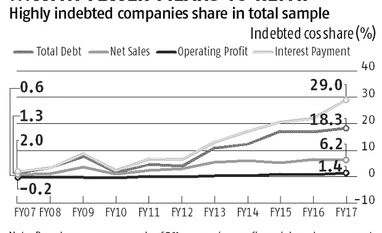The list of financially stressed corporate entities grew longer in 2016-17 despite a general improvement in corporate profitability.
Nearly 11 per cent of the country’s largest listed companies, excluding banks and financial companies, could not service interest payments on their loans in 2016-17, up from nine per cent in 2015-16. These companies accounted for around a fifth of all gross corporate debt at the end of 2016-17.
In all, 85 companies had inadequate profits — operating profits lower than interest obligations — in 2016-17, up from 67 companies in 2015-16. These companies reported a combined operating profit of Rs 12,000 crore in 2016-17, lower than their cumulative interest obligation of Rs 60,000 crore.
The corresponding figures for the 67 companies in 2015-16 were Rs 5,100 crore of combined operating profit and Rs 43,200 crore in combined interest obligation.
The number of companies with inadequate profits was stable between 2012-13 and 2015-16 (see chart). When a company’s operating profit is lower than its interest obligation it is unable to service its debt, making its loans potential non-performing assets (NPAs) for banks.
Among the companies to join the list in 2016-17 were Alok Industries, Videocon Industries, Hindustan Construction, Castex Technologies, Uttam Galva, Usha Martin, Ruchi Soya and Amtek Auto.
Together, these 85 companies had gross outstanding loans of Rs 5.04 lakh crore at the end of 2016-17, up from Rs 4.6 lakh crore at the end of 2015-16. The number is expected to rise as more companies in the sample file their audited balance sheets for 2016-17. The current data are based on interim annual results in which many companies do not report consolidated numbers.
In 2015-16, the financially troubled companies reported 26 per cent higher debt compared to what they had reported during their quarterly filings. The analysis is based on a sample of 761 companies from the BSE 500, BSE Midcap and BSE Smallcap indices, excluding banks and financial companies and oil refining and marketing companies. The sample also excludes Vedanta and Tata Steel, which reported large non-cash losses in the recent past. It includes only those companies whose annual financial numbers are available since 2006-07.
“Overall stress remained unchanged in the fourth quarter of 2016-17, with debt having interest cover of less than one still at 40 per cent. The weak continue to get weaker, as companies with interest cover less than one saw a 35 per cent year-on-year decline in their operating profit. The share of debt with loss-making companies rose to 36 per cent from 32 per cent,” wrote Ashish Gupta and Kush Shah of Credit Suisse.
An interest cover of one means that a company is earning operating profit only enough to pay its interest obligation.
Others attribute the deterioration to demonetisation and a continued slowdown in industrial and investment activity. “A sudden drop in demand after the note ban hit the finances of many companies. We now see a cyclical recovery in the economy driven by government spending but this may not be of much help to indebted companies in capital intensive sectors,” said Dhananjay Sinha, head of equity and strategy at Emkay Global Financial Services. According to him, the economic recovery will be largely felt in the consumer demand-driven sectors while the bulk of corporate debt is lying in the books of capital-intensive sectors such as power, metals, infrastructure and real estate.
These stressed companies reported a combined net loss of Rs 60,300 crore and net sales of around Rs 2.83 lakh crore. Together these companies accounted for 18.3 per cent of the total gross outstanding loans in 2016-17 but only 6.2 per cent and 1.4 per cent, respectively, of the entire sample’s net sales and operating profit. The data suggest a steady rise in the proportion of corporate debt under stress. In 2011-12, 49 companies, accounting for 4.1 per cent of all corporate loans, had difficulty servicing their debts. The ratio has been rising steadily ever since.
A similar trend is visible in the quarterly results, where the universe is bigger. Interest payments exceeded operating profits for 744 companies during the March quarter, up from 665 companies during the previous quarter. There was an improvement over the March 2016 quarter, when 773 companies had reported inadequate profits.
However, despite a decline in their number, financially stressed companies reported greater losses in the fourth quarter of 2016-17 (Rs 37,603 crore) than in the fourth quarter of 2015-16 (Rs 29,834 crore).
The analysis is based on the quarterly results of a sample of 3,028 companies whose numbers are available for the last 20 quarters.
Unlock 30+ premium stories daily hand-picked by our editors, across devices on browser and app.
Pick your 5 favourite companies, get a daily email with all news updates on them.
Full access to our intuitive epaper - clip, save, share articles from any device; newspaper archives from 2006.
Preferential invites to Business Standard events.
Curated newsletters on markets, personal finance, policy & politics, start-ups, technology, and more.
)